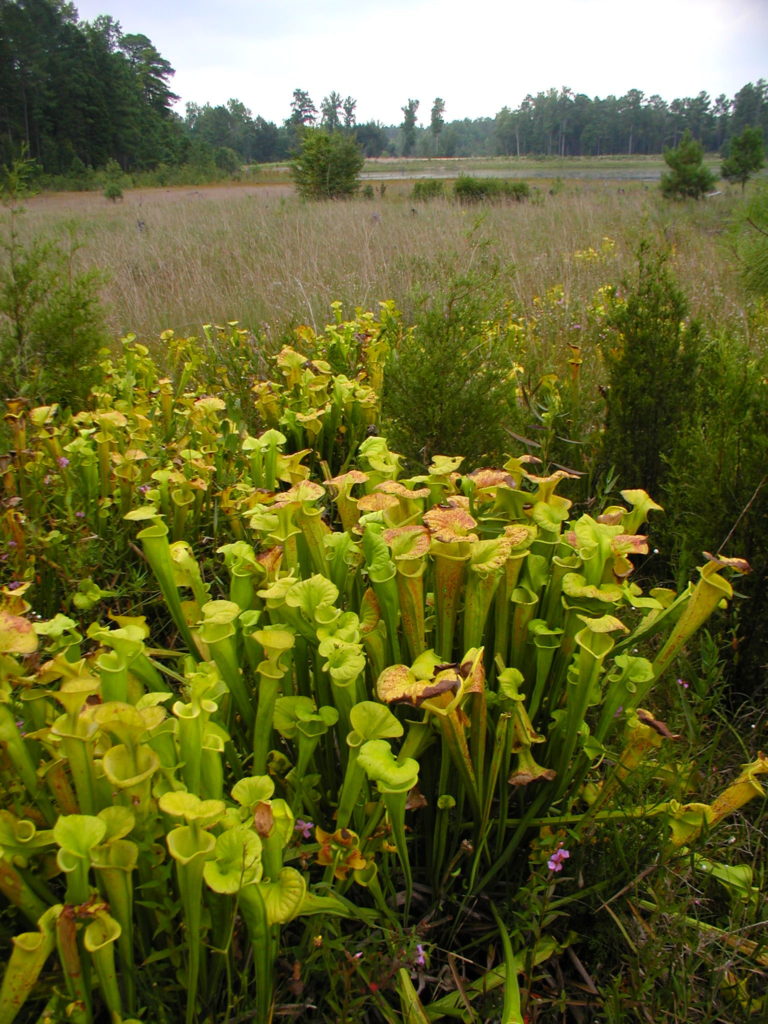Yellow Pitcherplant is an herbaceous perennial up to 3′ tall found in sandy bogs in the coastal plain regions of Virginia and south to Florida and west to Alabama. Like all pitcherplants, S. flava thrives in full sun. The long throat or tube is quite slender, and the hood is reflexed, the orifice quite open, its lip often spouted. There are several variants in terms of the colors displayed, which fade somewhat if grown in shadier spots. Early spring S. flava blooms are yellow and have strong, musty odor. Ideally, Yellow Pitcherplant should be sited in an established bog. However, it can easily be grown in a container in peat moss and sand or perlite, and watered with deionized water (to control salt accumulation), as long as it is allowed to undergo cold during its winter dormancy and is not permitted to dry out. Insects and spiders are attracted to the pitchers, which are colorful and fragrant and modified to then entrap the small creatures. The soft parts are digested enzymatically within the traps, supplying the plant with locally scarce nitrogen and phosphorus. Pitcher plants should never be fertilized!
NURSERY HOURS
Wednesday: 10-4 Thursday: 10-6 Friday-Saturday: 10-4 Sunday: 12-4
Sarracenia flava

Key Info
Scientific Name: Sarracenia flava L.
Common Names: Yellow Pitcherplant, Trumpets, Watches, Biscuit-flower
Family Names: Sarraceniaceae
Light Requirement: Full sun
Leaf Retention: Deciduous
Flower Color: Yellow
Additional Info
Habit: Sarracenias are clump-forming herbaceous perennials that grow as rosettes from a branching rhizome, forming colonies and containing fibrous roots 8-12 inches long along its length. The pitchers are modified leaves that (in addition to their function of photosynthesis) attract and entrap their insect prey by means of colorful presentation and nectar production (like flowers) and modifications to prevent escape. Wikipedia has a concise treatment of Sarracenia's entrapment mechanisms.
Height: 2'-3'
Spread: 1'-2'
Soil Conditions: Moist or wet, nutrient-poor, peaty, acidic soils.
Leaves: The pitchers are leaves modified to attract, capture, hold and digest animal prey. The pitchers of Yellow Pitcherplant consist of a more or less upright, slender tube (the trap) with a hood poised at the top with reflexed margins, the trap orifice being quite open. S. flava also produces long, slender, linear, winter leaves (phyllodia).
Flowers (or reproductive structures: A 5-petaled, bright yellow, inverted umbrella-like flower (to 2” diameter) hangs down from the tip of a leafless stem. Flowers typically have a strong musty fragrance.
Fruit: Each flower is followed by a dry 5-parted seed capsule that splits open along 5 seams at maturity (June/July) exposing small, papery, pear-shaped seeds. The seeds fall near the parent plant.
Natural Distribution: Bogs and savannahs primarily on coastal plain of Southeast.
USDA Hardiness Zone: 4 to 8
USDA Wetland Indicator Status in NC: OBL
Pollination: Bees, and other insects.
Wildlife Connections: Obtains nutrients (nitrate and phosphate) from insects. Insects and other tiny creatures are attracted by the nectar and coloration of the traps. The main prey of Sarracenias are ants, flies, wasps, bees, beetles, slugs and snails.
Propagation: Sarracenias can be propagated from seed or, more frequently, by division.
